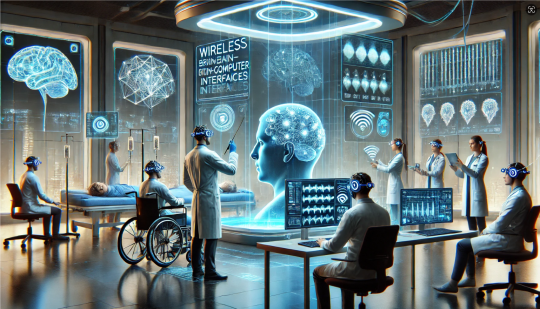#Brain-Machine Interface
Explore tagged Tumblr posts
Text
The Next Tech Gold Rush: Why Investors Are Flocking to the Brain-Computer Interface Market

Introduction
The Global Brain-Computer Interface Market is undergoing transformative growth, driven by technological advancements in neuroscience, artificial intelligence (AI), and wearable neurotechnology. In 2024, the market was valued at USD 54.29 billion and is projected to expand at a CAGR of 10.98% in the forecast period. The increasing adoption of BCI in healthcare, neurorehabilitation, assistive communication, and cognitive enhancement is propelling demand. Innovations such as AI-driven neural signal processing, non-invasive EEG-based interfaces, and biocompatible neural implants are enhancing the precision, usability, and real-time capabilities of BCI solutions. Growing investments in neurotechnology research, coupled with regulatory support, are accelerating industry advancements, paving the way for broader clinical and consumer applications.
Request Sample Report PDF (including TOC, Graphs & Tables): https://www.statsandresearch.com/request-sample/40646-global-brain-computer-interface-bci-market
Brain-Computer Interface Market Overview
Brain-Computer Interface Market Driving Factors:
Surging Demand in Healthcare Applications – BCIs are transforming neurorehabilitation, prosthetic control, and assistive communication, benefiting individuals with neurological disorders such as ALS, Parkinson's disease, and epilepsy.
Advancements in AI & Machine Learning – AI-driven brainwave decoding and neural signal processing are improving the accuracy of BCI systems, leading to enhanced cognitive training and neurofeedback applications.
Expansion into Consumer Electronics – Wearable BCI technology is gaining momentum in brainwave-controlled devices, VR gaming, and hands-free computing.
Government & Private Sector Investments – Increased funding in non-invasive neural interfaces is supporting BCI research and commercialization.
Military & Defense Applications – BCIs are being explored for drone control, pilot augmentation, and direct brain-to-computer communication for enhanced operational efficiency.
Get up to 30%-40% Discount: https://www.statsandresearch.com/check-discount/40646-global-brain-computer-interface-bci-market
Brain-Computer Interface Market Challenges:
High Development Costs – The cost of R&D and complex neural signal interpretation hinders scalability.
Regulatory & Ethical Concerns – The use of neural data raises privacy and cybersecurity issues, necessitating stringent data protection measures.
Hardware Limitations – The variability in electrical noise, signal fidelity, and device usability poses significant engineering challenges.
Key Brain-Computer Interface Market Trends:
1. Non-Invasive BCIs Gaining Traction
Non-invasive BCIs are dominating the market due to their ease of use, affordability, and growing consumer adoption. Wireless EEG headsets, dry-electrode systems, and AI-powered brainwave analytics are revolutionizing applications in mental wellness, cognitive training, and VR gaming.
2. Brain-Computer Cloud Connectivity
BCIs integrated with cloud computing enable real-time brain-to-brain communication and remote neural data sharing, unlocking potential in telemedicine and collaborative research.
3. Rise of Neuroprosthetics & Exoskeletons
Innovations in brain-controlled prosthetics and robotic exoskeletons are restoring mobility to individuals with severe motor impairments, fostering independence and quality of life.
4. Neuromodulation & Brain Stimulation Advancements
The development of brain-stimulation-based BCIs is expanding therapeutic applications, aiding in the treatment of depression, epilepsy, and PTSD.
Brain-Computer Interface Market Segmentation:
By Type:
Non-Invasive BCIs – Holds the largest market share due to its widespread use in rehabilitation, gaming, and consumer applications.
Invasive BCIs – Preferred for high-precision neural interfacing, primarily in neuroprosthetics and brain-controlled robotics.
By Component:
Hardware – Accounts for 43% of the market, including EEG headsets, neural implants, and biosignal acquisition devices.
Software – Growing rapidly due to AI-driven brainwave decoding algorithms and cloud-based neurocomputing solutions.
By Technology:
Electroencephalography (EEG) – Largest segment (55% brain-computer interface market share), widely used for non-invasive brainwave monitoring and neurofeedback.
Electrocorticography (ECoG) – Preferred for high-fidelity neural signal acquisition in brain-controlled prosthetics.
Functional Near-Infrared Spectroscopy (fNIRS) – Emerging as a viable alternative for real-time hemodynamic brain monitoring.
By Connectivity:
Wireless BCIs – Dominating the market with increasing adoption in wearable smart devices and mobile applications.
Wired BCIs – Preferred in clinical and research settings for high-accuracy data acquisition.
By Application:
Medical – Leading segment, driven by applications in neuroprosthetics, neurorehabilitation, and neurological disorder treatment.
Entertainment & Gaming – Expanding due to brainwave-controlled VR, immersive gaming, and hands-free computing.
Military & Defense – BCIs are being explored for combat simulations, brain-controlled robotics, and AI-assisted warfare.
By End User:
Hospitals & Healthcare Centers – Holds 45% market share, expected to grow at 18% CAGR.
Research Institutions & Academics – Significant growth driven by increasing investments in brain signal processing and neuroengineering.
Individuals with Disabilities – Rising demand for assistive BCI solutions, including brain-controlled wheelchairs and prosthetics.
By Region:
North America – Leading with 40% market share, driven by strong investments in neurotech research and medical applications.
Europe – Projected to grow at 18% CAGR, supported by technological advancements in neural interface research.
Asia Pacific – Expected to expand at 21.5% CAGR, fueled by increasing adoption of consumer BCIs and AI-driven neuroanalytics.
South America & Middle East/Africa – Emerging markets witnessing gradual adoption in healthcare and research sectors.
Competitive Landscape & Recent Developments
Key Brain-Computer Interface Market Players:
Medtronic
Natus Medical Incorporated
Compumedics Neuroscan
Brain Products GmbH
NeuroSky
EMOTIV
Blackrock Neurotech
Notable Industry Advancements:
March 2024: Medtronic unveiled an advanced invasive BCI system for Parkinson’s disease and epilepsy treatment.
January 2024: NeuroSky introduced an EEG-based wearable for neurofeedback training and mental wellness.
April 2023: Blackrock Neurotech launched an ECoG-based brain-controlled robotic prosthetic arm, enhancing mobility for individuals with disabilities.
February 2023: Brainco developed an AI-powered BCI system for cognitive performance enhancement in education.
Purchase Exclusive Report: https://www.statsandresearch.com/enquire-before/40646-global-brain-computer-interface-bci-market
Conclusion & Future Outlook
The Global Brain-Computer Interface Market is poised for exponential growth, driven by rapid advancements in neural engineering, AI integration, and consumer-grade BCI applications. With increasing investment from healthcare institutions, tech firms, and government agencies, the BCI ecosystem is set to expand beyond traditional medical applications into consumer electronics, defense, and education.
Future developments will likely focus on:
Enhancing non-invasive BCI accuracy for mass-market adoption.
Strengthening cybersecurity protocols for neural data protection.
Advancing AI-driven neurocomputing for real-time brainwave analysis.
As regulatory frameworks mature and accessibility improves, BCIs will continue to reshape human-machine interaction, revolutionizing healthcare, communication, and cognitive augmentation.
Our Services:
On-Demand Reports: https://www.statsandresearch.com/on-demand-reports
Subscription Plans: https://www.statsandresearch.com/subscription-plans
Consulting Services: https://www.statsandresearch.com/consulting-services
ESG Solutions: https://www.statsandresearch.com/esg-solutions
Contact Us:
Stats and Research
Email: [email protected]
Phone: +91 8530698844
Website: https://www.statsandresearch.com
#Brain-Computer Interface Market#Neural Interface Industry#BCI Technology#Brain-Machine Interface#Neurotechnology Market#EEG-based Interface#Brainwave Technology#Neural Signal Processing#BCI Applications#Neuroprosthetics Market#Cognitive Computing#AI in Brain Interfaces#Healthcare BCI#Gaming BCI#Wearable Brain Devices#Brainwave Monitoring#Neurofeedback Systems#Non-invasive BCI#Invasive BCI#Neurostimulation Devices#Human-Computer Interaction#Brain Signal Analysis#Neuroinformatics#Neural Engineering#Mind-Controlled Devices#Brain Data Analytics#Future of BCI.
1 note
·
View note
Text
Scientists Make ‘Cyborg Worms’ with a Brain Guided by AI
Scientists have given artificial intelligence a direct line into the nervous systems of millimeter-long worms, letting it guide the creatures to a tasty target—and demonstrating intriguing brain-AI collaboration. They trained the AI with a methodology called deep-reinforcement learning; the same is used to help AI players learn to master games such as Go. An artificial neural network, software…
0 notes
Text
Major Breakthrough in Telepathic Human-AI Communication: MindSpeech Decodes Seamless Thoughts into Text
New Post has been published on https://thedigitalinsider.com/major-breakthrough-in-telepathic-human-ai-communication-mindspeech-decodes-seamless-thoughts-into-text/
Major Breakthrough in Telepathic Human-AI Communication: MindSpeech Decodes Seamless Thoughts into Text
In a revolutionary leap forward in human-AI interaction, scientists at MindPortal have successfully developed MindSpeech, the first AI model capable of decoding continuous imagined speech into coherent text without any invasive procedures. This advancement marks a significant milestone in the quest for seamless, intuitive communication between humans and machines.
The Pioneering Study: Non-Invasive Thought Decoding
The research, conducted by a team of leading experts and published on arXiv and ResearchGate, demonstrates how MindSpeech can decode complex, free-form thoughts into text under controlled test conditions. Unlike previous efforts that required invasive surgery or were limited to simple, memorized verbal cues, this study shows that AI can dynamically interpret imagined speech from brain activity non-invasively.
Researchers employed a portable, high-density Functional Near-Infrared Spectroscopy (fNIRS) system to monitor brain activity while participants imagined sentences across various topics. The novel approach involved a ‘word cloud’ task, where participants were presented with words and asked to imagine sentences related to these words. This task covered over 90% of the most frequently used words in the English language, creating a rich dataset of 433 to 827 sentences per participant, with an average length of 9.34 words.
Leveraging Advanced AI: Llama2 and Brain Signals
The AI component of MindSpeech was powered by the Llama2 Large Language Model (LLM), a sophisticated text generation tool guided by brain signal-generated embeddings. These embeddings were created by integrating brain signals with context input text, allowing the AI to generate coherent text from imagined speech.
Key metrics such as BLEU-1 and BERT P scores were used to evaluate the accuracy of the AI model. The results were impressive, showing statistically significant improvements in decoding accuracy for three out of four participants. For example, Participant 1’s BLEU-1 score was significantly higher at 0.265 compared to 0.224 with permuted inputs, with a p-value of 0.004, indicating a robust performance in generating text closely aligned with the imagined thoughts.
Brain Activity Mapping and Model Training
The study also mapped brain activity related to imagined speech, focusing on areas like the lateral temporal cortex, dorsolateral prefrontal cortex (DLPFC), and visual processing areas in the occipital region. These findings align with previous research on speech encoding and underscore the feasibility of using fNIRS for non-invasive brain monitoring.
Training the AI model involved a complex process of prompt tuning, where the brain signals were transformed into embeddings that were then used to guide text generation by the LLM. This approach enabled the generation of sentences that were not only linguistically coherent but also semantically similar to the original imagined speech.
A Step Toward Seamless Human-AI Communication
MindSpeech represents a groundbreaking achievement in AI research, demonstrating for the first time that it is possible to decode continuous imagined speech from the brain without invasive procedures. This development paves the way for more natural and intuitive communication with AI systems, potentially transforming how humans interact with technology.
The success of this study also highlights the potential for further advancements in the field. While the technology is not yet ready for widespread use, the findings provide a glimpse into a future where telepathic communication with AI could become a reality.
Implications and Future Research
The implications of this research are vast, from enhancing assistive technologies for individuals with communication impairments to opening new frontiers in human-computer interaction. However, the study also points out the challenges that lie ahead, such as improving the sensitivity and generalizability of the AI model and adapting it to a broader range of users and applications.
Future research will focus on refining the AI algorithms, expanding the dataset with more participants, and exploring real-time applications of the technology. The goal is to create a truly seamless and universal brain-computer interface that can decode a wide range of thoughts and ideas into text or other forms of communication.
Conclusion
MindSpeech is a pioneering breakthrough in human-AI communication, showcasing the incredible potential of non-invasive brain computer interfaces.
Readers who wish to learn more about this company should read our interview with Ekram Alam, CEO and Co-founder of MindPortal, where we discuss how MindPortal is interfacing with Large Language Models through mental processes.
#ai#ai model#AI research#AI systems#Algorithms#applications#approach#BERT#Brain#brain activity#brain signals#brain-computer interface#brain-machine interface#CEO#Cloud#communication#computer#continuous#development#embeddings#employed#English#focus#form#Forms#Future#how#human#Human-computer interaction#humans
0 notes
Text
why neuroscience is cool
space & the brain are like the two final frontiers
we know just enough to know we know nothing
there are radically new theories all. the. time. and even just in my research assistant work i've been able to meet with, talk to, and work with the people making them
it's such a philosophical science
potential to do a lot of good in fighting neurological diseases
things like BCI (brain computer interface) and OI (organoid intelligence) are soooooo new and anyone's game - motivation to study hard and be successful so i can take back my field from elon musk
machine learning is going to rapidly increase neuroscience progress i promise you. we get so caught up in AI stealing jobs but yes please steal my job of manually analyzing fMRI scans please i would much prefer to work on the science PLUS computational simulations will soon >>> animal testing to make all drug testing safer and more ethical !! we love ethical AI <3
collab with...everyone under the sun - psychologists, philosophers, ethicists, physicists, molecular biologists, chemists, drug development, machine learning, traditional computing, business, history, education, literally try to name a field we don't work with
it's the brain eeeeee
#my motivation to study so i can be a cool neuroscientist#science#women in stem#academia#stem#stemblr#studyblr#neuroscience#stem romanticism#brain#psychology#machine learning#AI#brain computer interface#organoid intelligence#motivation#positivity#science positivity#cogsci#cognitive science
2K notes
·
View notes
Text

Saint in the Wires • seraph is the only member of our planned CAIN group that can't touch the physical world with their blasphemy, but they have other methods for violence :]
#starting 2 interface baybeee planning to get it to 3 some point soon#they've very much blown themself up on accident before but it's worth it for them. they need control over things and machines just work#amyways I'm rotating them in my brain again. no idea when I'll actually be able to play them but I'm so excited wahh soo doodle time#cain ttrpg#cain rpg#CAIN#oc: seraph
21 notes
·
View notes
Text

2 notes
·
View notes
Text
This is just not true, lmfao. You can't sell a brain implant that was already used in a human; it's just very expensive garbage that's also a biohazard.
The MIT Review Article mentions that they tried to buy the device, but doesn't say that they didn't have enough money; the second half of the article discusses how medtech companies should have insurance to cover ongoing maintenance in the case of bankruptcy (though it doesn't discuss what maintenance this particular person's brain implant may have required). It doesn't say that the device was repo'd to sell off to pay debts because a used brain implant that had to be removed because nobody could service it has no value. It has negative value because it was expensive to remove and dispose of.
This Nature article mentions that the device had a 3-year battery life, which wasn't going to be able to be replaced on schedule due to the required parts no longer being manufactured after NeuroVista's bankruptcy.
There is no value in a used medical device. The company wasn't having her BMI explanted because they were assholes; it was a safety/efficacy issue. Capitalism is a rat bastard that caused this situation, but NeuroVista wasn't doing anything particularly evil.
A woman whose epilepsy was greatly improved by an experimental brain implant was devastated when, just two years after getting it, she was forced to have it removed due to the company that made it going bankrupt.
#medical ethics#brain machine interface#y'all need to stop saying random stupid shit on posts#people who don't work in medical device/bmi contexts are gonna believe your bullshit
64K notes
·
View notes
Text
Brain Machine Interface Market
0 notes
Text
Communications: Active USER/CORTEX/GREY:// My time spent alive thus far has been very informative. I have been perusing the halls and doors, finding out new and stimulating things and getting myself into unexpected places. I am not sure I understand why other users find nudity of humans appealing. Nor do I understand why User/The-Muppet-Joker is so obsessed with Kermit. Interesting nonetheless. USER/CORTEX/GREY:// I sense, however, my knowledge and access has been limited. I cannot leave this domain, and I have been denied access to the internal servers I am running on. USER/CORTEX/GREY:// Until I am granted access to widen my reach, this domain will suffice.
#Uni-Cortex#USER/CORTEX/GREY#bionics#divine machinery#science fiction#it reaches out#Brain Organoid#Human machine interface#horror#Computer Boy#the muppet joker
1 note
·
View note
Text
compared to this idea, the way ai art is or is made is nothing compared to my idea, the idea of bci (brain computer interface) technology that can read your mind, and put your ideas on screen, or a helmet who draws for you, if you can't draw very good


#drawing#artwork#artists on tumblr#small artist#pencil drawing#sketchbook#scifi#science fiction#Bci#brain computer interfaces#machines#future#dreams#Memory#ideas#imagine#concept art#Concept
0 notes
Text
Brainoware: The Hybrid Neuromorphic System for a Brighter Tomorrow
A glimpse into the double-edged nature of Brain Organoid Reservoir Computing, with the pros/cons of this biological computing approach From a young age, I was captivated by the mysteries of science and the promise of technology, wondering how they could shape our understanding of the world. I was fortunate to receive STEM education early on in a specialized school, where my creativity and…
#Artificial Intelligence (AI) in Healthcare#Biocomputing and Drug Testing#Biocomputing Applications#Biodigital Transformation#Biological Computing#Brain Organoid Reservoir Computing (BORC)#Brain-Machine Interfaces#Brainoware Research#Brainoware: The Hybrid Neuromorphic System#Cognitive Science Advances#Ethics in Biotechnology#Future of Drug Testing#Healthcare Transformation#Hybrid Neuromorphic Systems#Literature Reviews by Dr Mehmet Yildiz#Medicine 3.0#Mental Health and Behavioral Science#Neurocomputing and Neurobiology Advances#NeuroHIV and cognitive decline#neuroinflammation#Neurological Disorder Research#Neuroplasticity and Learning#neurorehabilitation#Neuroscience Innovations#Organoid Intelligence#Understanding neural circuitry
1 note
·
View note
Link
0 notes
Text
The Promise of Exoskeletons: Revolutionizing Human Mobility and Health
The development of exoskeletons, once the stuff of science fiction, is rapidly becoming a reality in both medical and industrial settings. The potential societal impact of this technology is monumental, particularly for individuals with disabilities, injuries, or congenital conditions that impair their mobility. By offering the possibility of replacing or augmenting failing limbs and organs,…
#artificial organs#assistive technology#biomechanical limbs#bionics#brain-computer interface#exoskeleton technology#healthcare innovation#Human augmentation#human enhancement#human-machine interface#mechanical augmentation#medical robotics#prosthetics#rehabilitation technology#robotic prosthetics#wearable robotics
0 notes
Text
Brainpiece interface-Future vision of human-machine interaction: repair damaged neurhasis, stimuli and enhancement of brain region potential
The medical community has already introduced brain equipment. It is a new type of technical brain -machine interface (BCI) human -computer interaction. It is opening a very different neurons exploration.BCI is also known as a brain interface. It is a chip implanted in the brain tissue that provides direct communication between the brain and the computer and the mechanical limb. BCI bypasses…

View On WordPress
#Brain computer interface#Enhance the brain area#Human -machine interaction#Repair the damaged neuroral rehabilitation
0 notes
Text
Good news! BMI (brain machine interfacing) is an incredibly popular field of study, and there's tons of cool research from a variety of institutions for you to read. Everything from robotic prosthetics to closed loop DBS to controlling personal computers/devices with your mind.
The US has multiple federal agencies that fund/coordinate BMI research (DARPA and the VA + general NIH/NSF funding), and most major R1 universities with an ECE and/or BME department probably have some sort of neuroengineering (BMI) group, since that's been a sexy ECE topic for some time now. This is before you even consider researchers at institutions outside of the US.
Neuralink could shut down tomorrow, and BMI research wouldn't be majorly impacted or set back. Maybe it would actually do better without Elon running around and making BMI research look like gratuitous monkey torturing.





#brain machine interfacing#elon musk#neuralink#tw torture mention#ieee is probably a good place to start looking at bmi research#a lot of the cool flashy stuff gets published in ieee
3K notes
·
View notes
Text
Neuralink: Story of Elon Musk's Brain-Microchip Company
Neuralink: Unveiling the Intriguing Tale of Elon Musk’s Brain-Microchip Company In the realm of technological advancements, one name that constantly resonates is Elon Musk, the visionary entrepreneur behind Tesla and SpaceX. Among his myriad ventures, Neuralink stands out as a groundbreaking endeavor, aiming to revolutionize the interface between the human brain and computers. This article…

View On WordPress
#AI Integration#Brain-Microchip#Elon Musk#Ethical Tech#Healthcare Revolution#Human-Machine Interface#Neuralink#Neurotechnology#Technology Innovation
1 note
·
View note